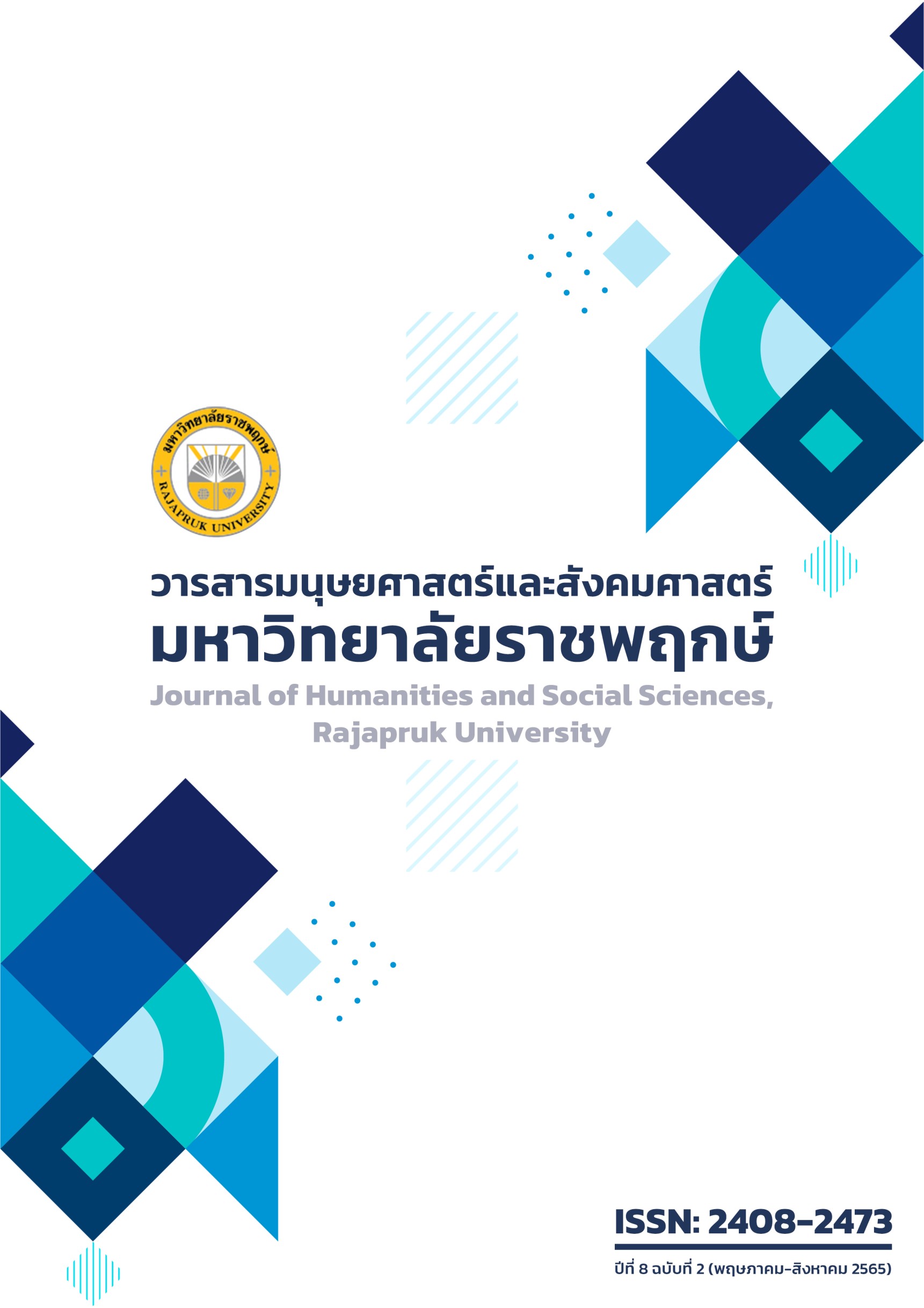The Development of an Enrichment Curriculum on Mathematics Problem Solving Skills using DAPIC Problem Solving Process for Sixth
Main Article Content
Abstract
The objectives of this research were to establish and explore the effectiveness of a curriculum for solving mathematical problems by using the concept of DAPIC problem-solving process for sixth-grade students and study the results of using the enrichment curriculum for sixth-grade students. The samples were 17 sixthgrade students, studying in the 2nd semester, the Academic Year 2020 at Ban Nong Pla Sawai School were obtained by cluster random sampling. The research instruments were the enrichment curriculum for solving mathematical problems, its manual, and a test for measuring mathematical problem solving skills. The data were statistically analyzed by applying means, standard deviation, and t-test dependent. The results of the research were as follows: 1. The enrichment curriculum on Mathematical problem-solving skills using the concept of DAPIC problem-solving process for the sixth-grade students included 7 elements: 1) background and significances 2) principles 3) aims 4) content structure 5) learning activities 6) learning materials and resources and 7) assessment. The results of the curriculum quality examination by an expert panel found that the enrichment curriculum on mathematical problem-solving skills using the concept of DAPIC problem-solving process for sixth-grade students obtained high overall suitability ( =4.48, SD=0.52). The effectiveness of the enrichment curriculum on mathematical problem-solving skills using the concept of DAPIC problem-solving process for sixth-grade students was 0.7322 which indicated that the student's learning progress post-studying was higher than pre-studying at a percentage of 73.22. 2. Students who studied with the enrichment curriculum on mathematical problems-solving using the concept of DAPIC problem-solving process had significantly higher Mathematical problem-solving skills of post-study than pre-study with statistically significant at a level of .05.
Article Details
References
กรมวิชาการ กระทรวงศึกษาธิการ. (2551). หลักสูตรแกนกลางการศึกษาขั้นพื้นฐาน พุทธศักราช 2551. กรุงเทพฯ: โรงพิมพ์ชุมนุมสหกรณ์การเกษตรแห่งประเทศไทย.
บ้านหนองปลาสะวาย, โรงเรียน. (2563). รายงานการประเมินตนเองของสถานศึกษา ปีการศึกษา2562. ลำพูน: โรงเรียนบ้านหนองปลาสะวาย.
รัตนะ บัวสนธ์. (2551). การวิจัยและพัฒนานวัตกรรมการศึกษา. พิษณุโลก: มหาวิทยาลัยนเรศวร.
รุจิร์ ภู่สาระ. (2545). การพัฒนาหลักสูตร: ตามแนวปฏิรูปการศึกษา. กรุงเทพฯ: บุ๊ค พอยท์.
วรณัน ขุนศรี. (2546). การจัดการเรียนการสอนคณิตศาสตร์. สงขลา: มหาวิทยาลัยสงขลานครินทร์.
วิชัย วงษ์ใหญ่. (2552). สารานุกรมวิชาชีพครูเฉลิมพระเกียรติพระบาทสมเด็จพระเจ้าอยู่หัว เนื่องในโอกาสมหามงคลเฉลิมพระชนมพรรษา 80 พรรษา. กรุงเทพฯ: สำนักงานเลขาธิการคุรุสภา.
สถาบันทดสอบทางการศึกษาแห่งชาติ (องค์การมหาชน). (2562). รายงานผลการทดสอบทางการศึกษาระดับชาติขั้นพื้นฐาน (O-NET) ชั้นประถมศึกษาปีที่ 6 ปีการศึกษา 2562, ฉบับที่ 6. ค้นเมื่อวันที่ 25 กันยายน 2563, จาก file:///C:/Users/BW_COMPUTER/Downloads/SbjStatbySchool_2562_P6_1051020028.pdf.
สถาบันส่งเสริมการสอนวิทยาศาสตร์และเทคโนโลยี. (2526). เอกสารเสริมความรู้คณิตศาสตร์ระดับประถมศึกษา เล่ม 2. กรุงเทพฯ: รุ่งศิลป์การพิมพ์.
สาคร แสงผึ้ง. (2550). การวิเคราะห์ข้อสอบแบบเลือกตอบโดยวิธี B-Index และการวิเคราะห์ ข้อสอบแบบคะแนนไม่ใช้ 0-1 ด้วยโปรแกรมคอมพิวเตอร์. ค้นเมื่อวันที่ 25 กันยายน 2563, จาก http://www.nitesonline.net/sakorn/page11.htm.
สุจริต เพียรชอบ. (2548). E Learning การพัฒนาหลักสูตร. กรุงเทพฯ: จุฬาลงกรณ์มหาวิทยาลัย.
สุณิสา สุมิรัตนะ. (2555). การพัฒนากระบวนการเรียนการสอนเพื่อส่งเสริมการรู้คณิตศาสตร์ของนักเรียนมัธยมศึกษาตอนต้น โดยใช้แนวคิดการศึกษาคณิตศาสตร์ที่เชื่อมโยงชีวิตจริงและกระบวนการแก้ปัญหา DAPIC. วิทยานิพนธ์ปริญญาครุศาสตรดุษฎีบัณฑิต จุฬาลงกรณ์มหาวิทยาลัย.
สุรชัย วงศ์จันเสือ. (2555). การพัฒนาความสามารถในการแก้ปัญหาทางคณิตศาสตร์และความสามารถในการคิดอย่างมีวิจารณญาณ โดยใช้การจัดกิจกรรมการเรียนรู้ตามแนวคิด DAPIC และ CGI ของนักเรียนชั้นมัธยมศึกษาปีที่ 3. คณะครุศาสตร์ จุฬาลงกรณ์มหาวิทยาลัย.
อัมพร ม้าคนอง. (2553). ทักษะและกระบวนการทางคณิตศาสตร์: การพัฒนาเพื่อพัฒนาการ. กรุงเทพฯ: โรงพิมพ์แห่งจุฬาลงกรณ์มหาวิทยาลัย.
อัมพร ม้าคนอง. (2554). ทักษะและกระบวนการทางคณิตศาสตร์:การพัฒนาเพื่อพัฒนาการ. พิมพ์ครั้งที่ 2. กรุงเทพฯ: โรงพิมพ์แห่งจุฬาลงกรณ์มหาวิทยาลัย.
Bybee, R. (1976). Transformation in Elementary Science Education. New York: New York University.
National Council of Supervisors of Mathematics. (NCSM). (1977). Position Paper on Basic. Arithmetic Teacher.
Taba, Hilda. (1962). Curriculum Development: Theory and Practice. New York: Harcourt Brace & world.


